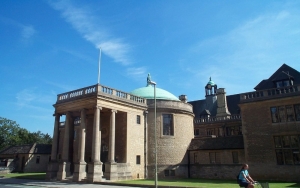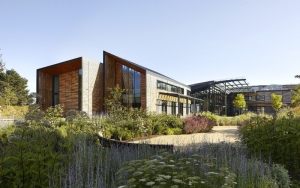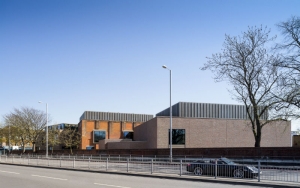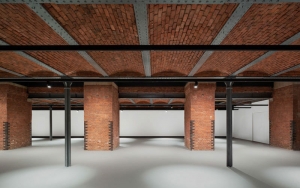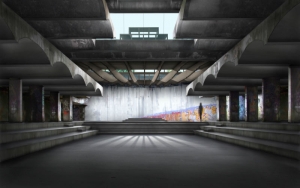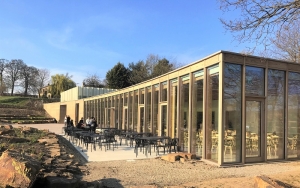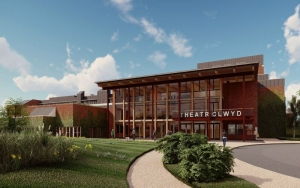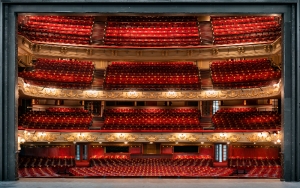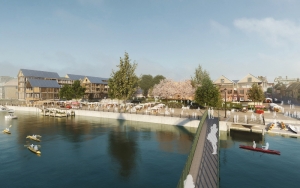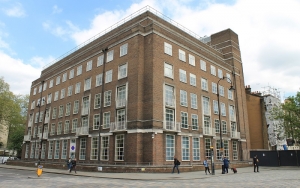Rhodes House, Oxford
Skelly & Couch has completed Stage 4 design at the Grade II*-listed Rhodes House, Oxford, for a new world-class convening hub designed to encourage the global exchange of ideas across all cultures and nationalities.
RHS Garden Wisley - National Centre for Horticultural Science and Learning
Garden Science Hub with Public Exhibition, Garden Science Hub with Public Exhibition, Members Library and Archive Space.
A 4,700m² hilltop building, featuring a roof terrace at the highest point of celebrated gardens within a significant Green Belt landscape, includes advanced research labs, libraries, and classrooms. Future-proof services for the building, gardens and the wider infrastructure were provided.
The RHS Hilltop development is the UK's first dedicated centre for horticultural and environmental science, featuring research labs, exhibition spaces, libraries, classrooms, an herbarium, and a café.
Skelly & Couch provided energy modelling, environmental design, and daylight and overheating analysis, drawing on experience from projects at the Royal Botanic Gardens, Kew, and Wakehurst Place. Working closely with garden designers, they created a climate-resilient, future-proof infrastructure for the Hilltop gardens and wider site.
The building’s design maximises natural light and ventilation through rooflights, while exposed thermal mass supports passive cooling, and high-specification glazing minimises summer overheating. A sustainable urban drainage system (SUDS) integrates ponds, infiltration trenches, basins, and swales into the landscape, with possible links to an irrigation storage pond.
To mitigate noise from the nearby A3 road, the herbarium archive is enclosed by thick walls, stabilising temperatures, while ground-coupled air ducts and hygroscopic materials further manage humidity, ensuring optimal conditions.
Active design measures further enhance the building’s sustainability, cooling draws on the site's irrigation system, using river and borehole water; and energy-saving features include photovoltaic cells offsetting 10% of the building's carbon emissions, mechanical ventilation with heat recovery, and coordinated power supplies to minimise voltage drop.
Beyond delivering MEP and sustainability services for the new building, Skelly & Couch also designed MEP, SUDs and drainage systems for the surrounding gardens and the wider infrastructure masterplan. The building form created three primary gardens— The Health and Wellbeing Garden (designed by Matt Keightley), The Wildlife Garden and The World Food Garden (both designed by Ann-Marie Powell) —along with smaller teaching and convening spaces.
RHS Wisley creates a sustainable hub for research, education, and community, with a harmonious integration of the building and landscape.
Awards
2021 – Guildford Design Award Winner Public Realm.
2021 – Guildford Design Award Winner Public Realm.
2022 – WAN Awards – Civic Institutes and Community Space Bronze.
2022 – AJ Architecture Award Finalist – Civic projects.
2023 – Civic Trust Award Regional Finalist.
2023 – Selwyn Goldsmith Award Finalist.
2023 – RIBA South East Award Winner.
An AJ Architecture Awards 2022 finalist in the Civic Projects category. A Regional Finalist for both a 2023 Civic Trust Award and a Selwyn Goldsmith Award for Universal Design. Winner of a 2023 RIBA South East Award. See the judges' citation: https://www.ribaj.com/buildings/regional-awards-2023-south-east-wilkinsoneyre-rhs-hilltop-culture-entertainment
Richmond Adult Community College
The historic Richmond Adult Community College, which has its roots in the late 19th century (1895), has been given a new and sustainable lease of life by an impressive refurbishment and new-build development, meeting the highest standards of energy efficiency.
Science and Industry Museum SEG Manchester
The £5m Special Exhibitions Gallery combines grand industrial beauty and stunning sustainable design as part of a masterplan to restore and renovate a Grade I-listed railway station, warehouse and Grade II-listed railway viaduct.
St Peter's RC Seminary, Cardross
Skelly & Couch has contributed to the first phase of the ‘rescue’ and restoration of one of Scotland’s greatest Modernist buildings, designed by Gillespie, Kidd and Coia, which has lain in ruins for 25 years.
The Weston, Yorkshire Sculpture Park
Sustainable centre within a historic landscape
A new centre with a unique, low-tech environmentally controlled and daylit gallery; restaurant, commercial kitchen and retail space. Heated by an air source heat pump and wastewater dealt with on site including a biodiverse swale system. Shortlisted for the Stirling Prize 2019.
Founded in 1977, the park is set in a former quarry on the estate of the 18th-century Bretton Hall. It was the first of its kind in the UK and remains the largest in Europe. The open-air gallery features works by renowned artists such as Henry Moore and Barbara Hepworth.
To enhance visitor experience and address reductions in public funding, a new visitor center was completed in 2019. Designed by Feilden Fowles, the 2016 Young Architect of the Year, the centre harmonises with the historic landscape while providing space for temporary exhibitions of 20th- and 21st-century artworks.
Skelly & Couch carried out full services design at the high-profile cultural destination, where the building’s internal climate is optimised for natural control as much as possible. Confronted with a site having no gas or drainage connections, a limited electrical supply and restricted services routes and zones around the building, some inventive engineering solutions were required.
Natural ventilation, solar control glazing and a green roof prevent overheating, ensuring a comfortable indoor environment. Inside the gallery, 10,000 unfired clay bricks form an innovative low-energy environmental control system that maintains optimal internal conditions and significantly reduces the reliance on air conditioning.
Complementing this, a sophisticated control system and humidity buffer—incorporating hygroscopic materials—work alongside a standard thermal wheel heat recovery unit to regulate temperature and humidity. A highly efficient scheme was developed using an electric heat pump to deliver both heating and domestic hot water to basins, eliminating the need for conventional hot water flow and return systems and thereby reducing energy consumption by over 50%. Additionally, underfloor heating provides a consistent sense of warmth throughout the space, even during periods of high visitor traffic and cold weather outside.
Designed with sustainability at its core, The Weston preserves the integrity of its setting while enhancing visitor comfort, engagement, and the Park’s cultural offering.
Awards
2019 – RIBA Stirling Prize Finalist
2019 – RIBA National Award
2019 – RIBA Yorkshire Award Winner
2019 – RIBA Yorkshire Building of the Year
2019 – RIBA Yorkshire Client of the Year
2021 – Civic Trust Award Winner
2021 – Civic Trust Awards Regional Finalist (Yorkshire & Humberside).
2022 – EU Mies van der Rohe Award Nomination. It was one of 18 projects longlisted in the UK, among 449 works in 41 countries featured.
Theatr Clwyd
Phased redevelopment of the Grade II-listed theatre kept it open via a pop-up auditorium. New foyer and rooms were added. Fabric and services upgrades, with new low-carbon heating, delivered ambitious energy targets. Stage and fly system modernised. BREEAM Very Good. 2021 Stage Awards winner.
Theatr Clwyd, a Welsh cultural landmark, is being transformed from its ageing 1970s infrastructure into a state-of-the-art, environmentally responsible venue. Addressing long-term resilience, accessibility, and future sustainability, the project balances heritage conservation with a bold shift to fossil-fuel-free operation.
Upgrades include expanded public spaces with a striking timber-framed foyer, a double-height rehearsal room, a dedicated learning studio, and fully modernised performance facilities—enhancing usability, accessibility, and audience experience while showcasing Wales's creative talent. Ongoing community consultation enabled the theatre to evolve with and for its users.
Skelly & Couch led a full systems overhaul targeting an 85% cut in operational carbon emissions. With a BREEAM ‘Very Good' rating, the project aims to be among the UK's first zero on-site emissions cultural venues.
A fabric-first retrofit targetted airtightness of 5 m³/h/m² @ 50 Pa, delivering year-round comfort and reduced energy demand. High-performance insulation and triple-glazed windows stabilise indoor temperatures and eliminate drafts, while natural ventilation wherever possible ensures fresh air without reliance on mechanical systems. Green roofs and walls add insulation, enhance biodiversity, and foster a calming connection to nature.
The project adopts an all-electric, heat pump–based strategy to eliminate fossil fuels. Gas boilers are replaced with air-source heat pumps for low-carbon heating and hot water, cutting emissions by two-thirds. A 1,000 m² rooftop solar array generates clean energy on-site, while MVHR provides filtered fresh air where natural ventilation is insufficient, minimising energy loss. Rainwater harvesting supplies toilets, easing demand on local infrastructure and reinforcing responsible resource use.
Theatr Clwyd proves how sensitive adaptation and sustainable design can enrich one another, creating a flexible, future-ready venue that prioritises wellbeing, performance, and long-term resilience.
Testimonials
"Skelly & Couch are extremely experienced at working on complex buildings and their knowledge and great attention to detail have been very beneficial to this public-facing project.” Jack Tilbury, Client Project Manager, Plann Limited
Awards
2021 - Planning Awards finalist. Best Use of Arts, Culture or Sport in Placemaking
2021 - Stage Awards Winner, Regional Theatre of the Year
Theatre Royal Drury Lane
The Grade I-listed Theatre Royal Drury Lane, owned and managed by Andrew Lloyd Webber’s LW Theatres and built originally in 1812, is set to regain its status as the prime venue for musical theatre in London.
Twickenham Riverside
Skelly & Couch are part of the winning multidisciplinary team led by Hopkins Architects which has beaten four other contenders in a RIBA competition to develop Twickenham Riverside.
Warburg Institute
Refurbishment and extension of one of the world’s leading scholarly institutions.
Phased refurbishment of the world-leading center in a conservation area, focusing on preservation through environmental control. It includes the historic libraries, a new archive and gallery, an extension with a lecture theatre and reading room; and supports future district heating decarbonisation.
The Warburg Institute, at the University of London’s Bloomsbury campus, is a renowned humanities research institute and library. Housed in a 1950s four-story building with a lower ground floor, it holds a globally significant collection. Its open-stack library of over 360,000 volumes is the largest dedicated to the afterlife of antiquity and cultural transmission, with key materials secured in the archive.
Renovation began with library stacks and academic offices on the upper floors, followed by the first and second floors. The final phase transformed the ground and lower ground levels, adding a reception, gallery, special collections archive, photographic room, and a courtyard extension with a floating lecture theatre and archive reading room. Two AV-equipped classrooms replaced the former lecture theatre and connect to the new one, accommodating larger audiences. Plant facilities were upgraded throughout.
Passive strategies included double-height lightwells to bring daylight into the special collections reading room, reoriented library stacks to reduce sun exposure, and new secondary glazing to limit heat loss, improve thermal performance, and protect materials with integrated UV film.
Skelly & Couch worked with the existing district heating system to serve renovated areas and upgraded it to support future decarbonisation. Fragile ceilings required careful coordination with the structural engineer to ensure safe MEP installation. New heating with improved controls serves the building, while humidifiers in the libraries maintain moisture during heating periods. MVHR ventilates the gallery, lecture theatre, and reading room; toilets use extract-only systems. In the lecture theatre, an air source heat pump provides cooling during busy periods. Energy-efficient LED lighting with occupancy sensors and daylight dimming, along with low-flow water fittings, was installed throughout.
Archive materials were relocated to a windowless, insulated lower-ground room , designed to meet stringent storage standards. Thermally coupled to the ground, it is passively climate-controlled, with a dehumidifier to manage external moisture.
The renovation secures the Warburg Institute’s legacy of discovery and learning, creating welcoming, functional spaces for visitors and staff while safeguarding invaluable materials. The project achieved an SKA ‘Gold’ rating.
FT: Warburg Institute renovation to bring enigmatic establishment into 21st century
Awards
2025 - AJ Architecture Awards, Refurbishment (£10m and Over) and Higher Education categories, shortlisted.

